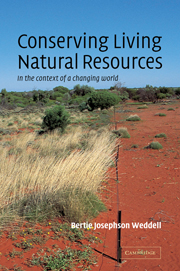Book contents
- Frontmatter
- Contents
- Preface
- Introduction: Balance and flux
- Methodology: Getting the information we need to manage living natural resources
- Part I Management to maximize production of featured species – a utilitarian approach to conservation
- 1 Historical context – the commodification of resources and the foundations of utilitarian resource management
- 2 Central concepts – population growth and interactions between populations
- 3 Central concepts – habitats
- 4 Techniques – harvest management
- 5 Techniques – habitat management
- 6 Techniques – management to minimize conflicts between pest species and people
- Part II Protection and restoration of populations and habitats – a preservationist approach to conservation
- Part III Management to maintain processes and structures – a sustainable-ecosystem approach to conservation
- Postscript
- Appendix: Scientific names of organisms mentioned in the text
- Index
4 - Techniques – harvest management
Published online by Cambridge University Press: 05 June 2012
- Frontmatter
- Contents
- Preface
- Introduction: Balance and flux
- Methodology: Getting the information we need to manage living natural resources
- Part I Management to maximize production of featured species – a utilitarian approach to conservation
- 1 Historical context – the commodification of resources and the foundations of utilitarian resource management
- 2 Central concepts – population growth and interactions between populations
- 3 Central concepts – habitats
- 4 Techniques – harvest management
- 5 Techniques – habitat management
- 6 Techniques – management to minimize conflicts between pest species and people
- Part II Protection and restoration of populations and habitats – a preservationist approach to conservation
- Part III Management to maintain processes and structures – a sustainable-ecosystem approach to conservation
- Postscript
- Appendix: Scientific names of organisms mentioned in the text
- Index
Summary
Classifying species on the basis of utilitarian values
The disciplines of wildlife management, range management, and forestry in North America developed in large part as a reaction to the excessive exploitation of birds and mammals by market hunters and to overgrazing and excessive timber cutting (see Chapter 1). Hence, it is not surprising that these disciplines sought to regulate exploitation by managing harvests of economically valuable species.
This approach to management embodies a utilitarian view of species. In 1885 the U.S. Department of Economic Ornithology (which was at that time a part of the Department of Agriculture) began studies of the economic value of birds. These studies classified species as good or bad, according to whether they were deemed beneficial or harmful to agriculture. Harmful species were those that consumed crops; beneficial ones ate the harmful species. These studies promoted the cause of conservation through their claim that many nongame birds played an important role in the control of insects and weeds. The underlying message, however, was that some species were better than others and that as many pests as possible should be killed.
Species that were considered useful were managed to enhance their populations. Under the new resource management policies, these species were protected (by the Lacey Act, for example) or harvested in a controlled fashion. On the other hand, species that were considered pests were managed to reduce their populations. This chapter looks at the regulated harvest of wild plants and animals.
- Type
- Chapter
- Information
- Conserving Living Natural ResourcesIn the Context of a Changing World, pp. 99 - 122Publisher: Cambridge University PressPrint publication year: 2002



